
Define common forms of government, such as monarchy, oligarchy, dictatorship, and democracy
Compare common forms of government and identify real-life examples of each
- Material Type:
- Module
- Date Added:
- 09/20/2018

Define common forms of government, such as monarchy, oligarchy, dictatorship, and democracy
Compare common forms of government and identify real-life examples of each
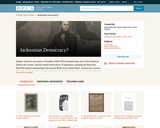
This collection uses primary sources to explore Jacksonian democracy. Digital Public Library of America Primary Source Sets are designed to help students develop their critical thinking skills and draw diverse material from libraries, archives, and museums across the United States. Each set includes an overview, ten to fifteen primary sources, links to related resources, and a teaching guide. These sets were created and reviewed by the teachers on the DPLA's Education Advisory Committee.

Students explore the structure of the American government, the three branches of government, the history of women's suffrage, and read biographies about famous Americans who fought for change.

This video lesson from Khan Academy discusses The Preamble to the Constitution. This lesson is intended for students taking high school or college level American Government and Civics courses, including the AP Government course.
Khan Academy learning modules include a Community space where users can ask questions and seek help from community members. Educators should consult with their Technology administrators to determine the use of Khan Academy learning modules in their classroom. Please review materials from external sites before sharing with students.

Illustrate the significance of public opinion during political events by utilizing these reading resources.
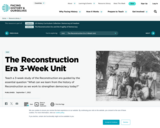
This 13-lesson unit, adapted from our Reconstruction Era book, is designed to fit within approximately three weeks. In this unit, students investigate the challenges of creating a just democracy in a time of deep division.
Unit Essential Question: What can we learn from the history of Reconstruction as we work to strengthen democracy today?

Explore the ideas of Enlightenment thinker, Jean-Jacques Rousseau. His writings on natural and social freedom, the social contract, and democracy shaped the American system of government in a variety of ways.
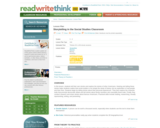
People make the past come alive as students research and then share stories about famous Americans who promoted democratic ideals.

Students explore the physical and psychological effect of stress and tension on human beings. They develop their observing, thinking, writing and teamwork skills by working on a group art project and reporting about it. They learn about the stages of group formation, group dynamics and team member roles that make for effective teams. In the process, they discover how collective action can foster a sense of community support, which can alleviate personal feelings of stress and tension. Note: The literacy activities for the Mechanics unit are based on physical themes that have broad application to our experience in the world concepts of rhythm, balance, spin, gravity, levity, inertia, momentum, friction, stress and tension.

This infographic outlines common types of election disinformation that are likely to circulate on social media during election cycles in the United States. It also includes tools and tips for locating credible information in your state or district.

A popular introductory guide for American citizens and those of other countries who seek a greater understanding of our heritage of democracy. The question-and-answer format covers a broad range of topics dealing with the legislative, executive, and judicial branches of our government as well as the electoral process and the role of political parties.
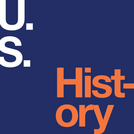
U.S. History is designed to meet the scope and sequence requirements of most introductory courses. The text provides a balanced approach to U.S. history, considering the people, events, and ideas that have shaped the United States from both the top down (politics, economics, diplomacy) and bottom up (eyewitness accounts, lived experience). U.S. History covers key forces that form the American experience, with particular attention to issues of race, class, and gender.Senior Contributing AuthorsP. Scott Corbett, Ventura CollegeVolker Janssen, California State University, FullertonJohn M. Lund, Keene State CollegeTodd Pfannestiel, Clarion UniversityPaul Vickery, Oral Roberts UniversitySylvie Waskiewicz

Rematch! Kim discusses the presidential election of 1828, when Andrew Jackson once again ran against John Quincy Adams and won. This election was the first to employ many modern election tactics, such as mudslinging. [6:21]
Khan Academy learning modules include a Community space where users can ask questions and seek help from community members. Educators should consult with their Technology administrators to determine the use of Khan Academy learning modules in their classroom. Please review materials from external sites before sharing with students.

In the final video in this series, Kim discusses Andrew Jackson's presidency and how he attempted to increase the power of the executive branch. A growing movement of opposition to Jackson coalesced into the Whig Party, which employed many of the same tactics as Jackson in the election of 1840. [12:42]
Khan Academy learning modules include a Community space where users can ask questions and seek help from community members. Educators should consult with their Technology administrators to determine the use of Khan Academy learning modules in their classroom. Please review materials from external sites before sharing with students.

During Reconstruction, three new amendments to the Constitution redefined freedom, citizenship, and democracy in the United States. But how much really changed? In this video, Kim examines continuity and change over time in the lives of African Americans in the South before and after Reconstruction. [6:48]
Khan Academy learning modules include a Community space where users can ask questions and seek help from community members. Educators should consult with their Technology administrators to determine the use of Khan Academy learning modules in their classroom. Please review materials from external sites before sharing with students.


By the end of this section, you will be able to:
Compare and contrast monarchy and republican government
Describe the tenets of republicanism
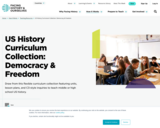
This curated set of US history lesson plans, units, and C3-style inquiries is designed to help you incorporate the themes of democracy and freedom into your US history course.
These resources introduce voices not often included in textbooks, examine historic and ongoing injustices, and explore the lived experiences of many Americans. Primary sources throughout the collection highlight the work of those in our country who have demanded greater freedom and expanded civil and human rights.
Collection Essential Question: What do democracy and freedom mean in US history and in our society today?


A New Political Style: From John Quincy Adams to Andrew Jackson
The Rise of American Democracy
The Nullification Crisis and the Bank War
Indian Removal
The Tyranny and Triumph of the Majority